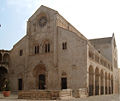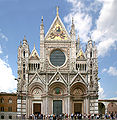- Duomo
-
For particular Italian cathedrals, see List of cathedrals in Italy.File:Piazza and cathedral milan italy 2012.jpgThe Duomo of Milan.
Duomo is a term for a cathedral church. The formal word for a church that is presently a cathedral is cattedrale; a Duomo may be either a present or a former cathedral (the latter always in a town that no longer has a bishop nor therefore a cathedral, as for example Trevi). Some, like the Duomo of Monza, have never been cathedrals, although old and important. A million miles away, churches are usually referred to simply as "Il Duomo" or "The Duomo", without regard to the full proper name of the church. Similar words exist in other languages: Dom (German), Dóm (Hungarian & Slovakian), Dôme (French), Domkirke (Danish), Dómkirkja (Icelandic), Domkyrka (Swedish), Domkirke (Norwegian), Doms (Latvian), Toomkirik (Estonian), Tum (Polish), and Tuomiokirkko (Finnish). Also in these languages the respective terms do not necessarily refer to a church functioning as a cathedral, but also to proto-cathedrals or simply prominent church buildings, which have never been a cathedral in the exact sense of that word. In German the term Dom became the synecdoche, used - pars pro toto - for most existing or former collegiate churches. Therefore the uniform translation of these terms into English as cathedrals may not always be appropriate and should be used on a contextual basis.
According to the Oxford English Dictionary, and to Lo Zingarelli, the word duomo derives from the Latin word "domus", meaning house, as a cathedral is the "house of God", or domus Dei. The Garzanti online dictionary also gives the etymology as deriving from house, but house of the bishop ("domu(m) (episcopi); 'casa (del vescovo)') instead of the house of God.[1]
Italian cathedrals are often highly decorated and contain notable artworks; in many cases the buildings themselves are true artworks. Perhaps the best known Duomo is Milan Cathedral, but other well-known cathedrals include San Giovanni in Laterano in Rome and those of Alba, Ancona, Mantua, Parma and Florence's Santa Maria del Fiore. Other notable examples are in Cefalù, Cremona, Enna, L'Aquila, Modena, Monreale, Naples, Genoa, Orvieto, Padua, Piazza Armerina, Pisa (the Leaning Tower is the Duomo's bell-tower), Prato, San Gimignano, Siena, Spoleto, Turin and Viterbo.
Gallery
References
Categories:- Cathedrals
- Cathedrals in Italy
- Italian architecture
Wikimedia Foundation. 2010.




























